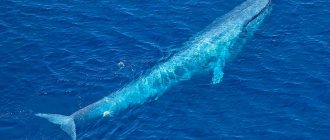Many people mistakenly believe that the largest fish in the world is the whale. But this is an absolute misconception, since it refers to mammals. The whale can easily be called the largest animal on Earth. But if we talk about what the largest fish in the world is, then the statistical data is different, and the registered indicators differ slightly from the unofficial ones.
The whale is far from the biggest fish
Fish-Napoleon
The fish are most often found among calcareous geological structures in the Red Sea, Pacific and Indian Oceans. Habitat depth: 1–100 meters.
This is the longest fish of the wrasse family. Adult specimens can reach a length of 230 cm. The average body length is 60 cm. Giants weigh over 190 kg.
The family got its name from its plump lips, thick forehead and clearly visible growth on its head. The body is painted in shades of lilac, gray, and green.
The underwater inhabitant prefers to live away from other representatives of the species. The Napoleon fish is diurnal and does not swim beyond its territory. At night it hides in corals. The diet consists of crustaceans, cuttlefish, and fish.
Napoleon is the largest predatory fish, which is not averse to feasting on poisonous species - starfish and urchins. They are sociable and make contact with people.
Salmon
Salmon
Family: Salmonidae
Like trout, salmon is a member of the salmon family. There are about nine species of salmon, all of which come from two different genera. A few other fish species are called salmon in different parts of the world but are not salmon (for example, Australian salmon and Hawaiian salmon).
Today, salmon species are widely farmed in different regions of the world, but they are found in the Atlantic and Pacific oceans. Most salmon species are anadromous; a migration pattern in which fish migrate from the ocean to fresh water to hatch or spawn.
It is widely believed that anadromous salmon return to the same location where they hatched. Tracking and behavioral studies have shown that this is largely true.
Giant grouper (Guasa)
In their natural habitat, they inhabit the Caribbean Sea and the waters of Brazil. The body of giant groupers reaches 2.5 m in length. They belong to the Serranidae family.
The history of the species suggests that the largest fish caught in the ocean weighed 363 kg. Guasa is characterized by dense meat with excellent taste, so it was destroyed for a long time due to taste preferences.
Fishermen, instead of the usual name - giant grouper, affectionately call them - guas.
In the modern world, thanks to the ban on mass grouper fishing, the number of rock perch individuals is slowly increasing. Territorial fish do not allow anyone into their territory - coral reefs. The carcass is heavy, massive, flat skin formation with spines. The diet includes fish and turtles.
Zander
Zander
Pike perch is a predator, feeds on small fish and leads a secretive lifestyle. In places of active hunting, especially during the feeding process, it is not difficult to catch it. Due to its gluttony, it can be caught even by a novice fisherman. Pike perch is valued for its healthy dietary meat, containing a lot of protein.
This type of fish can be found not only in fresh lakes and rivers of Russia, but also in the seas: Black, Baltic, Azov, Caspian. Usually the weight of caught pike perch is 8-10 kg. However, there is a documented case of catching a fish weighing 22 kg. They also say that the largest pike perch was caught in the last century on the Volga River, its weight was 40 kg.
Chinese paddlefish (Psephur)
Psefur is an inhabitant of the Yangtze River in China. Representatives of the Sturgeon family reach over 3 meters in length. The nose is elongated, which resembles the beak of a bird. Large individuals weigh 200 kg.
The paddlefish is an active fish and swims long distances. While moving, the psefur opens its mouth wide, into which food falls - small fish, plankton. The length of the largest fish caught was 7 meters and weighed 300 kg.
Psefur is an endangered species. Waste from industrial enterprises thrown into rivers has led to a reduction in the food supply for paddlefish.
Hoodwinker fish (Mola tecta)
The first specimen of the giant sunfish was described from a photograph by ichthyologist Ralph Foster and Marianne Nygaard. The Hoodwinker bears similarities to the common sunfish. But in 2022, it was separated into a new species and received the name hudvinker, which translated means “deceiver.” For 130 years before Marianne and Ralph, there had been no new species discovered.
Mola tecta are large fish up to 3 meters long and weighing over 2 tons. It is still unclear how, with such dimensions, they hid from the eyes of scientists for a long time. Habitat: Chile, New Zealand, Australia.
Large representatives of the world's oceans
Among the specimens living in the world's oceans, there are fish of simply incredible size. It's hard to imagine that they can grow to such an impressive length. Many people believe that the largest fish is a whale, but this is not entirely correct. The whale is a member of the mammal family, which means it is not a member of the fish family.
Whale shark
The largest fish in the world is the whale shark; representatives of this species can reach large sizes, some grow up to 12 meters. In the wild it grows more slowly than in an aquarium, this is due to the large amount of food that is provided in aquariums. There is an aquarium in Taiwan where a shark lives, adding 1 cm every day; it feeds on plankton and small fish; in one hour it can pass up to 6,000 cubic meters of water through its gills. The whale is distinguished by its small head size, which is strongly flattened. The teeth are small, but their number is incredibly huge, can reach up to 15 thousand.
According to unconfirmed reports, in the ocean you can find a representative weighing about 35 tons and up to 20 meters long
Giant shark
The basking shark ranks second in size and can easily be called the largest fish on earth. The giant shark reaches an average length of 10 meters and weighs about 5 tons. The largest specimen that a person saw was more than 12 meters in length and weighed 9 tons. It is interesting that such a shark was caught in a herring net. Currently, such large individuals are no longer found, the reason for this was large-scale fishing for basking sharks. The giant feeds differently from the majority of sharks; it does not absorb food, but filters everything that gets into it due to the fact that it swims with its mouth open.
A giant shark's stomach can hold half a ton of food.
Fish belt
In another way, this representative can be called the herring king. This is an unusual and longest fish in the world. It is often confused with a sea snake; the thickness of the body is only 5 cm with a body length of up to 5 meters. The belt fish can be seen swimming among the herring, which is how it got its second name. The unusual shape of a fish often attracts people; after catching one of its representatives, many people want to capture this event.
The belt fish is believed to be a harbinger of earthquakes
Moonfish
This individual consists of a large number of bones and reaches large sizes - up to 3 meters in length and 1.5 tons in weight. Its body looks like a flat circle, with equal length and width.
You can also read:
Which fish is the fastest?
The mouth is always open due to the fact that the mouth is beak-shaped due to the fused teeth.
The teeth have grown together to form a beak, which does not close completely, and it turns out that the mouth is always slightly open.
Another record of this representative is fertility. At one time, caviar contains several hundred million eggs.
You can meet it in all oceans, but its favorite pastime is at a depth of 200 meters at a water temperature no warmer than 10 degrees. Of modern large-sized fish, the moonfish is the most harmless for humans and does not pose a danger.
Sunfish have no scalesGuasa, or giant grouper
The giant grouper is often found in shallow waters in the tropics and can reach lengths of up to 2.5 meters. Guasa is considered an endangered species and is prohibited for fishing. Thanks to this ban, the grouper population began to increase. Guasa is able to protect its territory from invasion, it becomes aggressive and can even attack a person. The giant grouper can be called a predator.
Top articles: South African mongoose
The diet of the giant grouper includes various fish, small turtles and octopuses
Blue marlin
Blue marlin is one of the largest fish in the world. It reaches 5 meters in length. Females are much larger than males. Marlin lives in the Atlantic Ocean and is considered a favorite prey for sport fishing enthusiasts; catching it is considered a great success.
Great white shark
The largest predatory fish is the great white shark, its length reaches 6 meters. The great white shark lives in the ocean and poses a serious danger to humans, as it loves coastal water, as a result of which it often attacks people. The white shark is a rare species; their population is very small. The average lifespan of a white shark is about 70 years; sexual maturity in females occurs only at 33 years, and in males - at 26.
A great white shark attacks a person, but only when he invades its hunting territory
Sunfish (Mola mola)
The moonfish has an unusual body shape, flattened on both sides. An interesting feature of the moon fish is the relationship between body weight and brain size: a ton/walnut, respectively.
The diet consists of eggs, larvae, plankton, and fry. Representatives of ray-finned fish do not have a tail; their body is rounded. In its natural habitat it inhabits warm seas. Residents of Asia consider meat an exquisite delicacy. But Europeans and Australians avoid this delicacy, since Mola mola meat contains many parasites.
The largest representative of the sunfish was caught off the coast of Indonesia. It weighed 2.3 tons and was 3 meters long.
A 4-meter-long inhabitant of the underwater world was spotted in Sydney. Representatives prefer a separate lifestyle. Schools of sunfish can only be found during the breeding season.
Carp
Carp
Scientific name: Cyprinus carpio
The common carp is a popular fish species used for both food and sport. Although the common carp is native to Asia and Europe, it has been successfully introduced to other regions of the world.
There is a striking difference in shape and size between domesticated and wild carp. Domesticated ones tend to be bulkier and larger, sometimes up to 4 times larger than wild carp. The largest known specimen of the species weighed about 45 kg.
A single female carp can lay around a million eggs in a year, but only a few survive as they fall prey to a wide range of fungal and bacterial infections. Common carp are known to interbreed with goldfish.
Despite their popularity as fish food, the common carp is recognized as a pest in some parts of the world due to its highly destructive and invasive nature. In Australia, authorities are working on several methods to curb their explosively growing population.
Beluga
Belugas are the largest predatory fish in the Sturgeon family. Habitat: Azov, Adriatic, Black, Caspian seas. During spawning, beluga rises to the mouths of rivers flowing into the seas. At this time it is of interest to fishermen.
In the history of the species, specimens reaching 10 m in length were described, but were not registered. Such giants were found in the Volga. The official record is 420 cm, weighing more than a ton. Prefers to swim alone. Has a long mustache, a sharp nose, and a huge body.
Read on our website: how much does the largest whale in the world weigh?
Serbia, Bulgaria, Turkey are countries where belugas are artificially bred. Representatives of the sturgeon family are crossed with each other to obtain a more stable species that will spawn off the coast of large cities.
Giant freshwater manta ray
The opaque rivers of Borneo, New Guinea, Australia, and East Asia are the favorite habitats of the giant freshwater stingray. The largest representative of eagle rays was caught in China. The body length of a large manta ray was 4.5 m, weight – 500 kg.
A characteristic feature of the river stingray are dangerous poisonous spines 40 cm long. As soon as the stingray senses danger, it shoots these spines and pierces the skin of the enemy. The blow is so strong that it easily pierces the bottom of the boat and the skin of the bull.
People swimming in coastal waters and fishermen can suffer from stingrays. No one fishes for them, but the stingrays themselves end up in nets.
Northern right whale
Belongs to the same family as the southern right whale and is very similar in size and appearance. The body length reaches 18 m and weighs about 80 tons. Its usual habitat is the northern latitudes of the Atlantic Ocean. It feeds on crustaceans and fish, filtering them through whalebone. Whales of this species usually stay near feeding areas in the coastal zone, which has become the reason for their mass extermination. At the moment, the number is only 300-450 individuals. Despite the fact that hunting for these whales has been completely banned, the population is practically not recovering. Every year, researchers record more deaths of northern giants than births of babies.
Tiger shark
A leopard or tiger shark is disturbing the peace of surfers exploring the Caribbean Sea in Hawaii and harassing swimmers in Florida.
Anecdotal evidence suggests that the length of the tiger shark varies between 7.5–9 m. But the Guinness Book of Records recorded a shark with a body length of 6.3 m in length and weighing 1 ton 524 kg.
Gray whale
Whales with a characteristic grayish-brown color are common in the cold, temperate and subtropical waters of the Pacific Ocean. They prefer coastal areas and can stay in shallow water. Here they feed on benthic organisms, scooping them up with their huge mouths along with silt and pebbles and then filtering them through the whalebone. The maximum body length of these sedate giants is 15 m, and their weight does not exceed 35 tons. Gray whales are considered record holders among mammals for covering long distances during seasonal migration; in a year they can swim a distance of 19 thousand km.
Common catfish
The European or common catfish is an inhabitant of deep-sea places.
The diet includes fish, fresh meat, and carrion. Large individuals easily drag small animals and swimmers under water. The weight and length of the largest catfish caught by fishermen was 500 kg and 5 m, respectively. Habitats: large lakes, ponds, rivers of all continents.
There are no scales on the body. The teeth are arranged in several rows and resemble brushes in appearance. The eyes are small, set apart. A gregarious lifestyle is observed only in the cold season. In one habitat, up to 10 specimens can be counted. They spawn in special nests. The largest inhabitants were caught in France and Italy, on Lake Issyk-Kul.
Atlantic blue marlin
Blue marlin has an interesting feature - changing body color when in danger. The surface takes on a blue tint. The largest individuals found in nature weighed 500 kg with a body length of 5 m.
Distinctive features of marlin that distinguish it among fish: scales are shaded blue, a sharp and long nose, in the form of a spear. The predatory fish swims at a speed of 100 km/h. Fishermen who manage to catch marlin using a spinning rod are very lucky.
The teeth are arranged in several rows in the mouth. The nose is so sharp that it can pierce an aluminum boat with alloying elements.
Diet: flying fish, tuna. Marlins silence schools of fish with their tails, open their mouths and swallow food as they move. The meat of a representative of the Perch family is dense and very juicy.
bowhead whale
The largest of the right whale family, the only representative of the genus Balaena, has chosen the polar regions of the Northern Hemisphere. He tries not to be directly among the ice, but when this does happen, he makes his way, splitting ice floes up to 22 cm thick. The body length of female whales of this species reaches 22 m, and their weight is 150 tons. Due to such impressive dimensions, they swim very slowly, at a speed of about 20 km/h. Such slowness made whales easy prey for whalers, since they could catch up with the giant even in an ordinary rowing boat. Hunting bowhead whales is now prohibited. According to scientists, there are about 10,000 individuals in the modern population.
Great hammerhead shark
The enormous size of the body rightfully gives the shark an honorable place in the list of super-large representatives of the Hammerhead shark family.
The average body length of fish is 3.5 m. The largest hammerhead shark, which is officially recorded, has a body of 6.1 m. Representatives are considered dangerous, but they attack humans in rare cases.
Sperm whale
The largest representative of the suborder of toothed whales. It grows up to 20 m in length, and its weight can reach 50 tons. This whale cannot be confused with any other species due to its very striking external differences. His huge head, compressed at the sides and pointed, appears rectangular in profile. It makes up at least a quarter of the total body length. The mouth is located at the bottom of the head, while the jaw moves down 90 degrees. These whales are common in all oceans, only avoiding icy polar waters. They feed mostly on cephalopods; they also eat fish, but in small quantities.
Great white shark
Among the population, the white shark received other names: big shark, killer shark, carcharodon. Everything about the white shark is impressive: its strong jaws and enormous size. The great white shark is the largest inhabitant of the world's oceans (compared to other sharks) and the most dangerous predator, posing a threat to human life. The average length of representatives of the species is 4.5 m.
There is evidence that fishermen caught specimens with a body length of 6 m. The killer shark is considered an endangered species. There are only 3,500 great white sharks in the world.
gold fish
gold fish
Scientific name: Carassius auratus
Goldfish are perhaps the most common aquarium fish in the world. If you have or have ever owned an aquarium, there is a good chance that you keep a goldfish as a pet.
Based on body characteristics and coloration, goldfish can be divided into 300 varieties. Most known varieties of goldfish come from China, where they were first developed about 1,000 years ago.
Carassius auratus is also one of the best studied freshwater fish species. Numerous studies have shown that goldfish have powerful cognitive and learning abilities. In one such study, researchers found that goldfish can differentiate between different colors and shapes. They also have a memory period of three months.
Giant shark
The largest representative of the family of the same name reached 9.8 m in length and weighed 4 tons.
Neither the basking shark nor the whale shark pose a danger to humans. Just don’t touch the body of a giant shark with your hands. There are scales with sharp tips on the surface, so touching them can cause injury.
sei whale
A rare whale of the minke family, it is considered an endangered species. It grows up to 18 m in length, extremely rarely - up to 20 m. Weight reaches 30 tons. It lives in all oceans, avoiding the very cold waters of Antarctica and the Arctic, as well as too warm tropical zones. It tries to stay alone or in pairs; in places where food accumulates, it can join herds of several dozen individuals. The basis of the diet of whales, common in the southern hemisphere, is black-eyed crustaceans. Representatives of northern latitudes eat fish, crustaceans and mollusks.
Strap fish (herring king)
The belt fish got its interesting name “Herring King” due to the fact that it can often be found at the head of a school of herring. In addition, the fish has a kind of crown on its head.
The legend of the "Sea Serpent" arose from an encounter between sailors and the Herring King. Sailors described the belt fish as a huge monster with a fiery mane on its head. The fact is that the fin on the back is painted bright red, so sailors confused it with a sword. The belt-fish was scientifically described in 1772. The first description was made by Peter Ascanius, a Norwegian zoologist. A specimen for research was washed up on the coast of Glesver.
The body is ribbon-shaped, 3.5 m in length. The average weight of representatives is 200 kg. There is a small mouth on the short head. The dorsal fin originates on the head and ends at the end of the body. Elongated rays form a kind of crown. There are no scales on the body and no swim bladder. The surface of the body is painted silver, the head has a blue tint. The fins are bright red.
Freshwater giants
Marine inhabitants, of course, are the most diverse and numerous, but river representatives can also amaze with their size and uniqueness. Therefore, when fishing in unfamiliar places, you need to take safety measures so as not to become a victim of some giant. No one knows how big the catfish in a nearby lake or river could grow to.
Arapaima
The largest freshwater fish is the arapaima. It grows up to 2 meters in length, but there is a legend in which a fisherman was lucky enough to catch an arapaima 4.5 meters long. This fish has large scales and large plates on its head. Interestingly, scales are many times stronger than bone. The main feature of this representative of the water element is that it breathes ordinary air, like mammals, and it inhales so loudly that it can be heard from afar.
Once every 20 minutes, the arapaima floats to the surface for a breath of fresh air.
Common catfish
The catfish grows up to 4 meters, and its weight can reach 300 kg. This fish has no scales; depending on its habitat, the color of the surface of the catfish’s body changes. The color can be: yellow, black, most often brown. They feed mainly on small fish and crustaceans. There are even known cases of attacks on humans. In winter, active activity decreases, catfish do not feed, gather in groups and wait out the cold times in pits.
Sexual maturity in the common catfish is reached at 3-4 years of age.
Giant freshwater stingray
It poses no danger to humans if handled correctly. It has two large spikes on its tail. He holds the victim with one, and injects poison into the other. When fishing, it always swings its tail, so you should be extremely careful.
Beluga
In the list of “Largest Freshwater Fish,” the beluga comes first. It belongs to the sturgeon family. This fish lives in the sea, but enters rivers to spawn. Some of the belugas spend the winter in rivers. She is a long-liver, tracking the age of some individuals, scientists have come to the conclusion that the beluga can live up to 100 years. The fish has a thick, cylinder-shaped body of ash-gray color. It is a predatory fish and its fishing is prohibited.
Beluga caviar is the most valuable in the world
Carp
Carp lives in freshwater; the main condition is that the reservoir has no current and the bottom is muddy. The body is covered with small scales. The largest carp caught by a person weighed 48 kg. It feeds on reed shoots, aquatic plants, mollusks and even the eggs of other fish.
White sturgeon
The third largest among the sturgeon family. The fish is quite aggressive, its color has white spots on the sides and on the back. The white sturgeon can reach 5-6 meters in length and weigh about 800 kg. They live quite a long time, their age can reach 110 years, sexual maturity occurs no earlier than 14 years for males, and no earlier than 18 years for females.
White sturgeon is the largest freshwater fish in the United States
Siberian taimen
Siberian taimen, or Russian salmon, belongs to the salmon family. She rightfully holds the title of the largest salmon in the world. The length of the fish can reach 1.5-2 meters, weight - 70-80 kg. It feeds on all smaller fish. The color varies, but the head is always olive green and the tail is red. Taimen grow larger than other salmon due to their long lifespan.
During the mating season, taimen acquires a copper-red color throughout the body.
Whale shark
The predatory fish can weigh up to 2.5 tons with a body length of 15 m. Such huge whale sharks cannot move quickly, the maximum speed is 5 km/h. The diet consists of plankton. They treat people peacefully, they even allow them to swim on their backs and give them rides.
The meat can be eaten, has high nutritional value and contains fatty acids. There are 15,000 hard processes on the surface of the smooth, mottled skin. On the flattened muzzle there is a wide mouth. Habitat: Africa, Philippines, oceans: Atlantic, Indian, Pacific.
Fish received their status due to their large body size. Among the representatives there are also predatory fish, which are distinguished by unbridled greed, and peaceful representatives, which do not pose a threat to people. In the process of evolution, the inhabitants of the underwater world became inventive and acquired a special intelligence.
Kandiru
Common Vandellia, or Whiskered Vandellia, or Candiru
The candiru (Vandellia cirrhosa) is an eel-like parasitic fish that grows on average no more than 2.5-6 cm. This tiny translucent creature is also called the “vampire fish” because it feeds on the blood in the gill cavities of other fish. Vandellia vulgaris inhabits the waters of South America, mainly the Amazon River, and attacks animals and people who swim here.
The candiru penetrates a person and extends short spines on its gills to anchor itself inside the organs and suck in blood. This leads to inflammation, hemorrhage and even death of the victim. Fish is difficult to remove from the body even with surgery.











